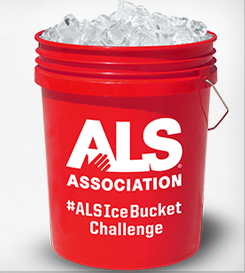 Social media have often drawn criticism – for their penchant to foster narcissism, time wasting, even bullying – but this past month we’ve seen the generosity, compassion and creativity they can generate. The ALS Ice Bucket Challenge has gone viral on the Internet, attracting a wide range of celebrities, athletes, professionals, students, business people, politicians, and ordinary folks – all dumping a bucket of ice water on their heads.
Social media have often drawn criticism – for their penchant to foster narcissism, time wasting, even bullying – but this past month we’ve seen the generosity, compassion and creativity they can generate. The ALS Ice Bucket Challenge has gone viral on the Internet, attracting a wide range of celebrities, athletes, professionals, students, business people, politicians, and ordinary folks – all dumping a bucket of ice water on their heads.
People have made donations to The ALS Association, challenging others to do so as well. In July alone, more than $100 million dollars was raised from a total of over 3 million contributors. These donations will fund research, searching for ways to ease the symptoms and slow the progression of ALS (Amyotrophic Lateral Sclerosis).
This summer marked the 75th anniversary of Lou Gehrig’s famous farewell speech in Yankee Stadium. That day, just weeks after receiving a diagnosis of ALS, he bravely stated, “Yet today, I consider myself the luckiest man on the face of this earth.” Lou Gehrig faced his challenge with humility and a positive outlook.
Pete Frates, diagnosed with ALS two years ago, said he wanted to use his condition to positively affect the lives of others. He became the inspiration for the 2014 Ice Bucket Challenge. Both men reacted with courage and fortitude, serving as role models and giving strength to their family and friends.
What can we learn from the success of the ALS charitable outreach? How can we best use the Internet to generate meaningful, positive actions? Here are 4 suggestions:
Encourage the expression of gratitude. When individuals focus on giving thanks, it improves their psychological and physical wellness and increases connections to the community, both real and virtual. Increased appreciation can lead to greater monetary support for philanthropies.
Engage the younger generation. Millennials are energized by giving, boosting messages to go viral. A survey of 20- to 35-year-olds in 2012 indicated that 75% of them had donated to charities the year before and had asked their friends to do so as well.
Make a public commitment to help. Progressing from a plan to a concrete action requires motivation as well as goals and objectives. The success of the Ice Bucket Challenge draws on social relationships, as participants dare friends to join them.
Publicize the progress of research. Currently, one Israeli company has developed a therapeutic technique using stem cells harvested from the patient’s own bone marrow and is in Phase 2 clinical trials in the United States. If these advanced clinical trials are successful, it will be the first significant breakthrough in fighting this debilitating disease.
We hope that, through the results of continuing outreach, donations, and research, future patients with ALS will be able to feel optimistic about their future, building on Lou Gehrig’s and Pete Frates’ expressions of gratitude about their past and present.









